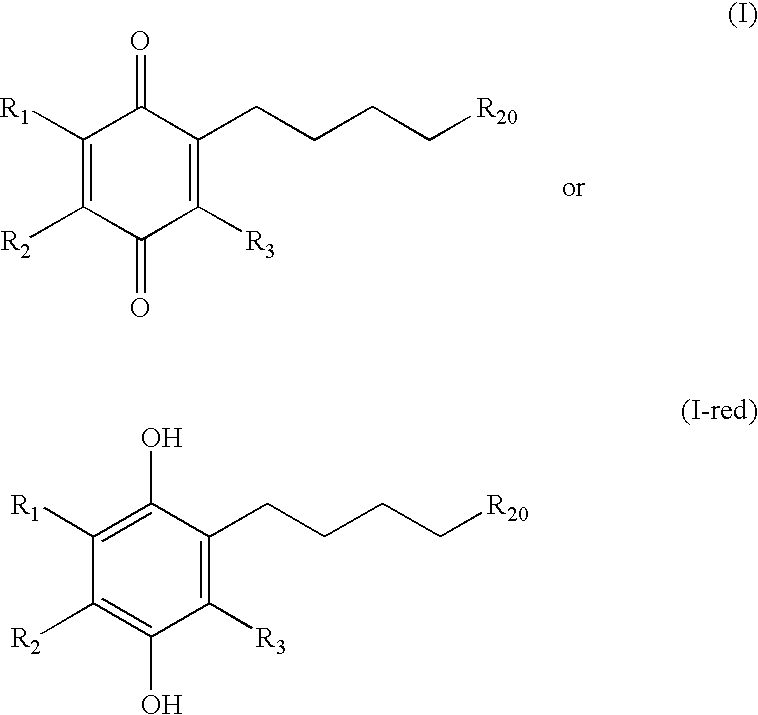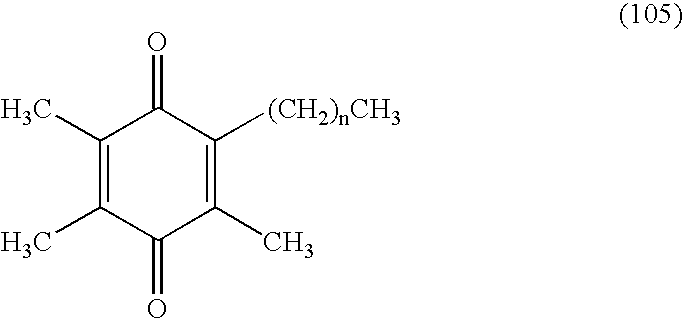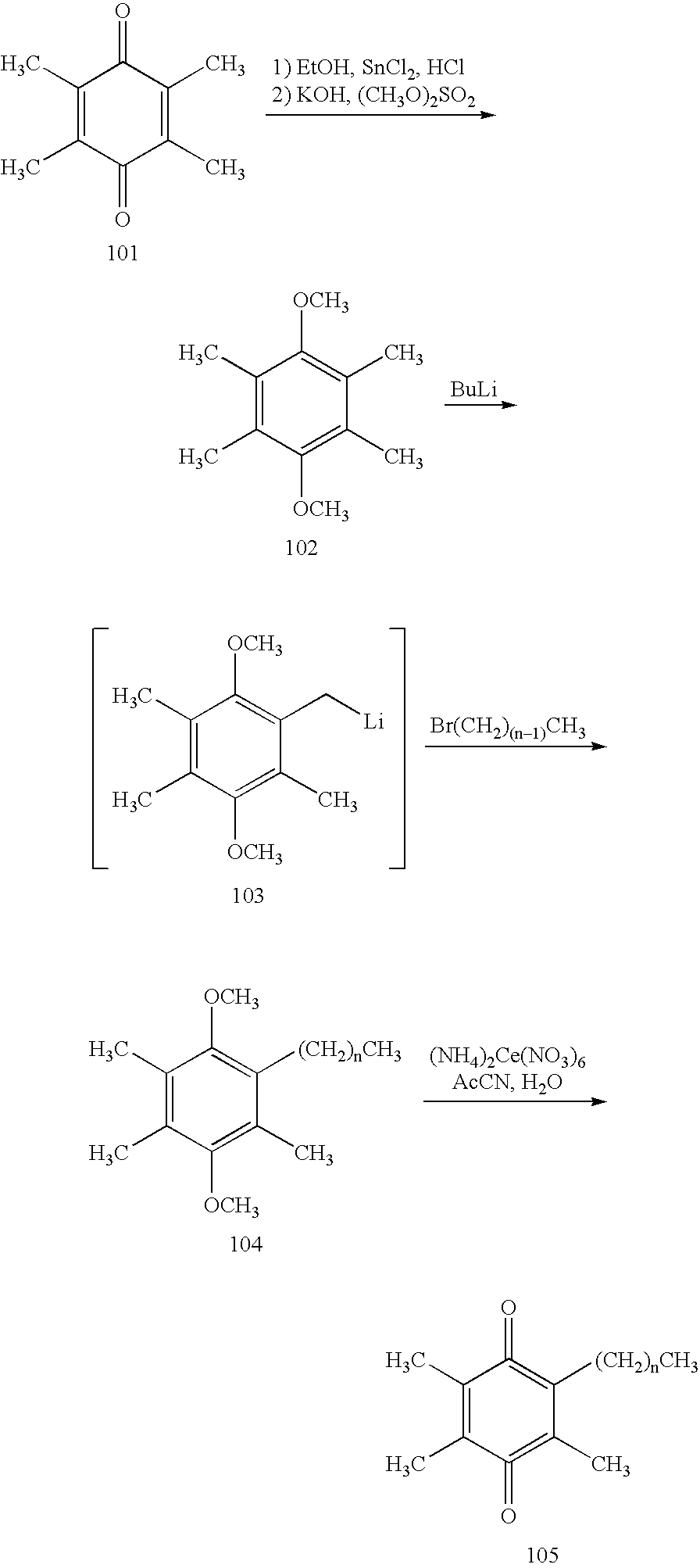Tail variants of redox-active therapeutics for treatment of mitochondrial diseases and other conditions and modulation of energy biomarkers
a redox-active therapeutic and mitochondrial disease technology, applied in the field of mitochondrial diseases and other conditions and modulation of energy biomarkers, can solve the problems of affecting the survival rate of mitochondrial cells, etc., to achieve the effect of reducing cytochrome c, reducing coenzyme q (coqred) levels, and reducing cytochrome
- Summary
- Abstract
- Description
- Claims
- Application Information
AI Technical Summary
Benefits of technology
Problems solved by technology
Method used
Image
Examples
example 1
[0106]
[0107] Step 1: A 2 L 3-N flask was charged with 2,3,5-trimethyl-benzene-1,4-diol (201; 50 g, 0.33 mol) and MEK (750 mL) to yield an amber solution. Potassium carbonate (210 g, 1.64 mol) was charged to the solution. After 30 min at room temperature, MeI (81.2 mL, 1.31 mol) was added to the brown suspension. The reaction mixture was heated to 65° C. for 72 h. After cooling to room temperature, the reaction mixture was concentrated to dryness by rotary evaporation to give a white paste. The paste was washed with EtOAc (3×300 mL). The EtOAc extracts were combined and concentrated by rotary evaporation. The resulting yellow-brown oil was chromatographed (80:20 / heptanes:EtOAc) to yield 1,4-dimethoxy-2,3,5-trimethyl-benzene (47.2 g, 80%). 1H NMR (400 MHz; CDCl3; ppm): 6.55 (s, 1H), 3.80 (s, 3H), 3.68 (s, 3H), 2.30 (s, 3H), 2.22 (s, 3H), 2.14 (s, 3H).
[0108] Step 2: A flask was charged with 1,4-dimethoxy-2,3,5-trimethyl-benzene (47.2 g, 0.26 mol), glacial acetic acid (250 mL), and par...
example 2
Decarboxylative Coupling
Example 2A
[0114]
[0115] To a 250 ml round bottom flask was added 2,3,5-trimethyl-[1,4]benzoquinone (1.50 g, 9.98 mmole), linolenic acid (2.94 g, 10.4 mmole), and silver nitrate (1.83 g, 10.8 mmole) in a 1:1 mixture of water and acetonitrile (100 ml). The solution was heated to 70° C. under argon and an aqueous solution of K2S2O8 (2.55 g, 11.5 mmole in 50 ml water) was added dropwise to the homogenous solution over 2.5 hours using a syringe pump. The reaction mixture was allowed to stir an additional 30 minutes at 70° C., then cooled to room temperature. To the mixture was added MTBE (200 ml) and water (100 ml). The organic layer was separated and washed with saturated NaHCO3 (100 ml), then brine (2×200 ml). The MTBE solution was dried over sodium sulfate then concentrated to a yellow oil. The crude product, which contained residual unreacted starting quinone by TLC, was further purified by silica gel chromatography (120 g, 0-30% EtOAc:heptane) to give pure 2...
example 2b
[0116]
[0117] To a 250 ml round bottom flask was added 2,3,5-trimethyl-[1,4]benzoquinone (0.51 g, 3.4 mmole), oleic acid (1.0 g, 3.5 mmole), and silver nitrate (0.62 g, 3.6 mmole) in a 1:1 mixture of water and acetonitrile (100 ml). The solution was heated to 70° C. under argon and an aqueous solution of K2S2O8 (0.86 g, 3.9 mmole in 50 ml water) was added dropwise to the homogenous mixture over 2.5 hours using a syringe pump. The reaction was stirred at 70° C. for an additional 30 minutes after addition, then cooled to room temperature. To the reaction mixture was added MTBE (200 ml) and water (100 ml). The organic layer was separated, washed with water (2×100 ml), then brine (2×100 ml). The solution was dried over sodium sulfate and concentrated to a yellow oil. The crude product was further purified by silica gel chromatography (120 g, 0-30% EtOAc:heptane) to give pure 2-heptadec-8-enyl-3,5,6-trimethyl-[1,4]benzoquinone (211; 25.2 mg, 2%) as a yellow oil. 1H NMR (400 MHz; d6-DMSO; ...
PUM
| Property | Measurement | Unit |
|---|---|---|
| temperatures | aaaaa | aaaaa |
| temperatures | aaaaa | aaaaa |
| temperatures | aaaaa | aaaaa |
Abstract
Description
Claims
Application Information
 Login to View More
Login to View More - R&D
- Intellectual Property
- Life Sciences
- Materials
- Tech Scout
- Unparalleled Data Quality
- Higher Quality Content
- 60% Fewer Hallucinations
Browse by: Latest US Patents, China's latest patents, Technical Efficacy Thesaurus, Application Domain, Technology Topic, Popular Technical Reports.
© 2025 PatSnap. All rights reserved.Legal|Privacy policy|Modern Slavery Act Transparency Statement|Sitemap|About US| Contact US: help@patsnap.com



